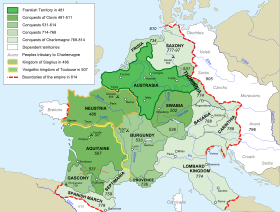Kingdom of Francia
| Kingdom of the Franks | ||||||||||||||||||
| Francia | ||||||||||||||||||
|
||||||||||||||||||
|
Orthographic map of the Frankish Kingdom at its greatest extent
|
||||||||||||||||||
|
Diachronic map of the Frankish kingdom at its greatest extent
|
||||||||||||||||||
| Capital | ||||||||||||||||||
| Languages | Old Franconian, Latin | |||||||||||||||||
| Religion | originally Frankish paganism, but virtually all Franks shifted to the Roman Catholic Church by 750 A.D. | |||||||||||||||||
| Government | Monarchy | |||||||||||||||||
| King of the Franks | ||||||||||||||||||
| • | 481–511 | Clovis I | ||||||||||||||||
| • | 613–629 | Chlothar II | ||||||||||||||||
| • | 629–639 | Dagobert I | ||||||||||||||||
| • | 751–768 | Pepin the Short | ||||||||||||||||
| • | 768–814 | Charlemagne | ||||||||||||||||
| • | 814–840 | Louis the Pious | ||||||||||||||||
| Historical era | Middle Ages | |||||||||||||||||
| • | Established | 481 | ||||||||||||||||
| • | Clovis I crowned first King of the Franks | 496 | ||||||||||||||||
| • | Charlemagne crowned Holy Roman Emperor | December 25, 800 | ||||||||||||||||
| • | Treaty of Verdun | 843 | ||||||||||||||||
| Area | ||||||||||||||||||
| • | 814 est. | 1,200,000 km2 (460,000 sq mi) | ||||||||||||||||
| Currency | Denier | |||||||||||||||||
|
||||||||||||||||||
Francia or Frankia, also called the Kingdom of the Franks (Latin: Regnum Francorum), Frankish Kingdom, Frankish Empire, Frankish Realm or occasionally Frankland, was a Barbarian kingdom inhabited and ruled by the Franks, a confederation of West Germanic tribes, during Late Antiquity and the Early Middle Ages.
The kingdom was founded by Clovis I, crowned first King of the Franks in 496. Under the nearly continuous campaigns of Pepin of Herstal, Charles Martel, Pepin the Short, Charlemagne, and Louis the Pious—father, son, grandson, great-grandson and great-great-grandson—the greatest expansion of the Frankish empire was secured by the early 9th century.
The tradition of dividing patrimonies among brothers meant that the Frankish realm was ruled, nominally, as one polity subdivided into several regna (kingdoms or subkingdoms). The geography and number of subkingdoms varied over time, but the particular term Francia came generally to refer to just one regnum, that of Austrasia, centred on the Rhine and Meuse in northern Europe. Even so, sometimes the term was used as well to encompass Neustria north of the Loire and west of the Seine.
Francia is regarded as the common predecessor of the modern states of France and Germany. After the Treaty of Verdun in 843, West Francia became the predecessor of France, and East Francia became that of Germany. Most Frankish Kings were buried in the Basilica of St Denis near Paris. Francia was among the last surviving Germanic kingdoms from the Migration Period era until its partitioning in 843.
...
Wikipedia


